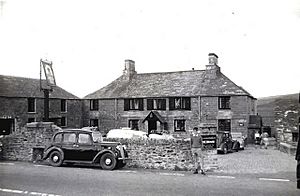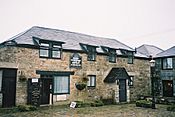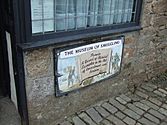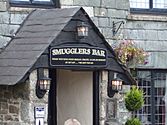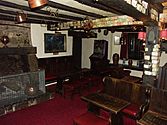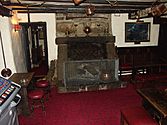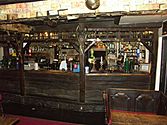Jamaica Inn facts for kids
| Jamaica Inn | |
Quick facts for kids 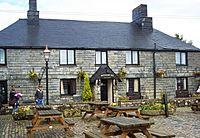 Jamaica Inn |
|
| Hotel facts and statistics | |
|---|---|
| Location | Bolventor, Cornwall, England, UK |
| Coordinates | 50°33′44″N 4°34′01″W / 50.56222°N 4.56694°W |
| Opening date | 1760/1776 |
The Jamaica Inn is a famous old inn located on Bodmin Moor in Cornwall, England. It was built in 1750 as a coaching inn, which was a place where horse-drawn coaches would stop to change horses and allow travelers to rest. The inn has a long history connected to smuggling.
It became very well-known because of Daphne du Maurier's 1936 novel, Jamaica Inn. This book tells a thrilling story about a secret group of smugglers. The novel was later made into a famous 1939 film directed by Alfred Hitchcock. However, the real inn was never used for filming.
The inn is also mentioned in a song called "Jamaica Inn" by Tori Amos. She wrote the song in 2005 after hearing legends about the inn while driving in Cornwall.
Contents
Exploring Jamaica Inn's Location
Jamaica Inn sits in the middle of Bodmin Moor, a wild and beautiful area in Cornwall. It's close to a small village called Bolventor. Nearby, you can find Brown Willy and Rough Tor, which are two of Cornwall's highest hills.
The inn covers a large area and has been updated over the years. Today, it works as a bed and breakfast, offering rooms for guests. It also has a pub, a museum, and a gift shop. A famous lake called Dozmary Pool is located about 2.4 kilometers (1.5 miles) south of the inn.
A Look Back at Jamaica Inn's History
An inn has been on this main road since 1547, but the current building was built in 1750. It was made bigger in 1778 with a coach house, stables, and a tack room. Many people think the inn got its name from smugglers who brought rum from Jamaica. However, the name actually comes from the important Trelawney family, who owned land nearby. Two members of this family were governors of Jamaica in the 1700s.
Cornwall was a perfect place for smugglers because of its many hidden coves and wild landscapes. The Jamaica Inn became a secret meeting point for smugglers. They used about 100 hidden paths to move their illegal goods.
There are old stories about "wreckers" who supposedly tricked ships onto the rocky coast in the early 1800s. The legend says they used lights to confuse ships, then looted them when they crashed. While these stories are popular, there isn't clear proof that this actually happened.
In 1847, Francis Rodd helped build a chapel in Bolventor for people living near Jamaica Inn. By 1856, a church, school, and parsonage were also built. The inn was a popular spot for hunters in winter and offered comfortable places to stay.
The building still has its old coach house, stables, and tack room from 1778. The famous novelist Alistair MacLean once owned the inn. It has been recognized as a historically important building since 1988.
In March 2022, the inn announced that it would no longer allow fox hunts on its property. The owner, Allen Jackson, explained that the hunts caused the inn to lose money. In August 2022, The Coaching Inn Group bought the hotel. This company operates many unique inns across the country.
The Inn's Design and Features
The Jamaica Inn is a two-story building built in the mid-1700s. Its roof is made of slate and has sloped ends. Over the years, parts of the building have been updated and extended. The outside of the inn is made of dark slate and stone.
You'll find a cobbled courtyard outside, which has an old rusty anchor and a classic red telephone box. Inside, the floors are a bit sloped, and you can see many of the original wooden beams. The fireplaces have large, rough granite pieces above them. The Smuggler's Bar especially feels like it's from the 1700s, with its big granite fireplace and dark wooden beams. The bar walls are decorated with old banknotes and items like brass kettles.
Museums at Jamaica Inn
Mr Potter's Museum of Curiosities
From 1984 to 2003, the inn was home to "Mr Potter's Museum of Curiosities." This museum had a large collection of taxidermy, which are stuffed animals arranged in detailed scenes. Imagine an animal courtroom or a school classroom filled with baby squirrels! These exhibits were created by Walter Potter in the 1850s. The collection was sold off in 2003.
The Museum of Smuggling
Today, the inn has "The Museum of Smuggling." It's located on the western side of the building. A sign outside says it shows "classical examples in the arts of concealment and evasion." The museum focuses on the history of smuggling and the inn's role in it.
The Cornish coast was a popular spot for smugglers to bring in goods like silks, tea, and brandy. This was because the coastline had many hidden spots and wasn't well-guarded by law enforcement. Many smugglers stored their hidden goods at the isolated Jamaica Inn. The museum displays various items, including "Wanted" posters from the late 1700s and old books. There's also a special display of items belonging to Daphne du Maurier, like her writing desk and typewriter, in the room where she stayed in 1930.
Images for kids


